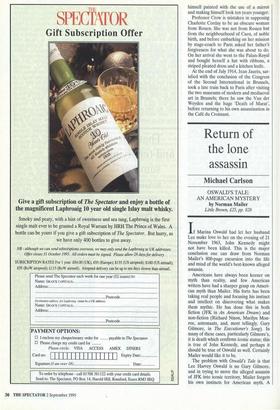Return of the lone assassin
Michael Carlson
OSWALD'S TALE: AN AMERICAN MYSTERY by Norman Mailer Little Brown, £25, pp. 828 If Marina Oswald had let her husband Lee make love to her on the evening of 21 November 1963, John Kennedy might not have been killed. This is the major conclusion one can draw from Norman Mailer's 800-page excursion into the life and mind of the world's best-known alleged assassin.
Americans have always been keener on myth than reality, and few American writers have had a sharper grasp on Ameri- can myth than Mailer. His forte has been taking real people and focusing his instinct and intellect on discovering what makes them mythic. He has done this in both fiction (JFK in An American Dream) and non-fiction (Richard Nixon, Marilyn Mon- roe, astronauts, and, most tellingly, Gary Gilmore, in The Executioner's Song). In many of these cases, particularly Gilmore's, it is death which confirms iconic status; this is true of John Kennedy, and perhaps it should be true of Oswald as well. Certainly Mailer would like it to be.
The problem with Oswald's Tale is that Lee Harvey Oswald is no Gary Gilmore, and in trying to move the alleged assassin of JFK into iconic territory, Mailer forgets his own instincts for American myth. A 'lone crazed assassin' might play better for his story, but reality has stacked the deck against such an interpretation of Oswald. The conspiracy itself has reached the level of myth.
Twenty-five years ago, we might have welcomed Mailer's excursion into the con- spiratorial quicksands of the assassination.
Today, the increasingly prolix Mailer (who has ignored the lessons in deception pro- vided in his lengthy CIA epic, Harlot's Ghost) seems content to tie extensive research and dubious sources together in a loose bow that comes undone almost instantly.
The new material in Oswald's Tale is an exhaustive combination of interviews con- ducted in Moscow and Minsk, along with transcripts of the KGB's bugging of Oswald and Marina's flat. Those looking for new insight into the mind and character of Oswald will be sorely disappointed — as will those looking for photographs. There is repetition, and at times Mailer seems keener on revealing the character of life in the old Soviet Union, not for any insight it may throw on Oswald or his motives, but just for the chance to apply his skills to another country. Certainly the new republic of Belarus may have welcomed that. But after all the information, the picture of Oswald still has huge questions, and Mailer's answers leave huge holes.
One expects the holes to be filled in when Oswald returns to the USA, but it is here that the book falls apart. Mailer's two main sources for this period are Priscilla Johnson MacMillan's Marina and Lee and Gerald Posner's Case Closed (Posner's book itself draws heavily on the former). This is akin to using Mein Kampf as your primary source for a book about the Holocaust.
The best that can be said of Marina and Lee is that government agents sequestered Marina Oswald, who feared deportation, and they granted the author exclusive access. Like others handed exclusives, she delivered what those granting the favour wanted: a portrait of a lone crazed assassin in the making. Mailer's interpretation of Marina's various testimonies is a keystone in granting Oswald his killer's status, yet as recently as 1993 at Harvard Marina her- self said unequivocally that 'Lee did not do it.'
Posner's book takes things one step fur- ther, by distorting or ignoring the case for a conspiracy. Mailer obviously distrusts Case Closed; he has referred to Posner as 'only intermittently reliable', and occasionally points out some of Posner's more blatant twistings of the record. Amazingly, he still uses it as a primary source. By relying on Posner, Mailer accepts a world full of bizarre coincidence, in which none of the coincidences are meaningful. Oswald becomes a homicidal Zelig: Woody Allen in the Texas School Book Depository, while the people who share history's stage with him simply disappear. Posner's book was billed as being definitive on the assassi- nation; really it is a clumsy bit of extended character assassination: if we can show Oswald really was a nutter then you'll ignore the evidence and believe he acted alone.
Having journeyed 800 pages trying to build a portrait of Oswald as a singular force in history, Mailer is obliged, like Posner, to ignore the most obvious inter- pretation of Oswald's seemingly delusional psyche: he was the perfect candidate to be someone's patsy. Mailer's coy dance around the subject of Oswald's possible homosexuality gives the word patsy a particular vibrancy. Don DeLillo showed us more of Oswald through those gay con- tacts, particularly the bizarre David Ferrie. Oliver Stone used Clay Shaw's sexuality to help demonise Oswald. For Mailer it mere- ly hints at why Marina wouldn't put out on that fateful night before.
Proving there was a conspiracy requires showing only that a few of the myriad coincidences of Oswald's life are not mere- ly random. Jack Ruby has always been an easy entry to that sweepstake. For example, when Ruby corrected police Capt. Fritz at the Friday press conference ('that's Fair Play for Cuba') we wonder (a) how Ruby knew the correct name of Oswald's bogus organisation and (b) why he thought it crucial to yell out. Maybe he was only seek- ing attention, but witnesses also place him in Dealy Plaza that morning, and with Oswald at the Carousel Club. If some facts which suggest conspiracy are real, then they also challenge the hypothe- sis of Oswald the lonely psycho, and we must seek another Gary Gilmore else- where.
Ordinary Oswald the Patsy would defeat Mailer's efforts to write an American tragedy. He is left with a mystery, but cannot solve it.
'I don't know which I like more —your photographs that look like paintings or your paintings that look like photographs.'



















































 Previous page
Previous page